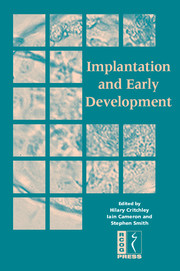Book contents
- Frontmatter
- Contents
- DECLARATION OF INTEREST
- Participants
- Preface
- SECTION 1 PREPARATION FOR IMPLANTATION – THE UTERINE ENVIRONMENT
- 1 Endocrine and paracrine signalling in the human endometrium: potential role for for the prostanoid family in implantation
- 2 Immunology of implantation
- 3 Progestin-indusced decidualisation promotes human endometrial haemostasis and vascular stabulity
- 4 Adhesion molecules and implantation
- 5 Vascular growth and modelling in the endometrium
- 6 Tissue remodelling the fetal-maternal interface: the regulation of matrix metalloproteinase 9 transcription
- 7 Embryo interactions in human implantation
- 8 Experimental models of implantation of the human embryo: reconstructing the endometrial–embryo dialogue in vitro
- SECTION 2 THE EMBRYO
- SECTION 3 LESSONS FROM ANIMAL MODELS (TRANSGENICS) AND NOVEL TECHNOLOGIES
- SECTION 4 CLINICAL SEQUELAE
- SECTION 5 CONSENSUS VIEWS
- Index
4 - Adhesion molecules and implantation
from SECTION 1 - PREPARATION FOR IMPLANTATION – THE UTERINE ENVIRONMENT
Published online by Cambridge University Press: 05 June 2014
- Frontmatter
- Contents
- DECLARATION OF INTEREST
- Participants
- Preface
- SECTION 1 PREPARATION FOR IMPLANTATION – THE UTERINE ENVIRONMENT
- 1 Endocrine and paracrine signalling in the human endometrium: potential role for for the prostanoid family in implantation
- 2 Immunology of implantation
- 3 Progestin-indusced decidualisation promotes human endometrial haemostasis and vascular stabulity
- 4 Adhesion molecules and implantation
- 5 Vascular growth and modelling in the endometrium
- 6 Tissue remodelling the fetal-maternal interface: the regulation of matrix metalloproteinase 9 transcription
- 7 Embryo interactions in human implantation
- 8 Experimental models of implantation of the human embryo: reconstructing the endometrial–embryo dialogue in vitro
- SECTION 2 THE EMBRYO
- SECTION 3 LESSONS FROM ANIMAL MODELS (TRANSGENICS) AND NOVEL TECHNOLOGIES
- SECTION 4 CLINICAL SEQUELAE
- SECTION 5 CONSENSUS VIEWS
- Index
Summary
The timing of implantation
There is evidence that the uterus is receptive to an implanting blastocyst from approximately 7 to 11 days after the luteinising hormone (LH) peak. Effective receptivity may well end in the human when corpus luteum rescue is no longer feasible,rather than as a result of a change in uterine properties. Thus the risk of early pregnancy loss increases with later implantation, from 13% on day 9 after ovulation to 82% on day 12 or later. Many conceptuses fail to implant because of genetic or metabolic abnormalities. Poor uterine receptivity has been widely proposed as another cause of implantation failure, but it remains unclear to what extent this may be because of defective synchronisation between embryo development and maternal differentiation, undetected embryo abnormalities, or a real failure of uterine capability to support implantation of a normal conceptus. For practical reasons, the term ‘implantation failure’ is often used to include a range of outcomes from blastocyst non-attachment to biochemical (human chorionic gonadotrophin (hCG)-positive) pregnancies that do not give rise to a functioning embryonic heart, that is to say, those that fail in the first 4—5 weeks. Such a definition encompasses implantation and placental organogenesis; this article mostly addresses the former, drawing pertinent comparative information from animal models. Knowledge of early placental development is emerging from mouse genetics and culture models but this lies outside the scope of the present discussion.
Keywords
- Type
- Chapter
- Information
- Implantation and Early Development , pp. 49 - 60Publisher: Cambridge University PressPrint publication year: 2005
- 1
- Cited by

